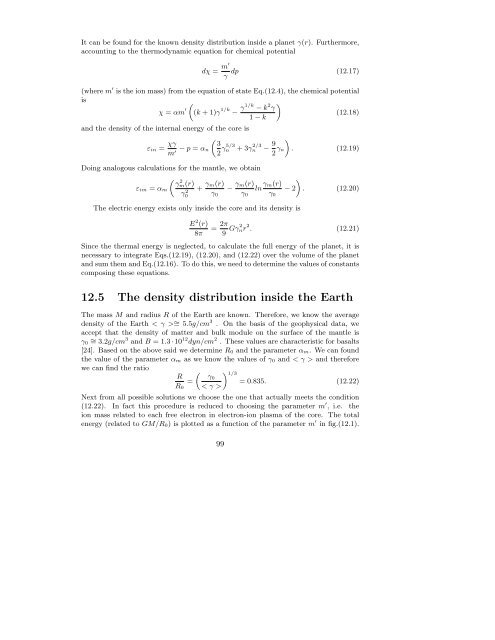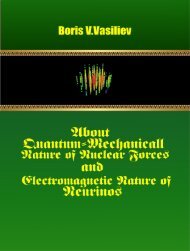VbvAstE-001
Book Boris V. Vasiliev Astrophysics
Book Boris V. Vasiliev
Astrophysics
Create successful ePaper yourself
Turn your PDF publications into a flip-book with our unique Google optimized e-Paper software.
It can be found for the known density distribution inside a planet γ(r). Furthermore,<br />
accounting to the thermodynamic equation for chemical potential<br />
dχ = m′<br />
dp (12.17)<br />
γ<br />
(where m ′ is the ion mass) from the equation of state Eq.(12.4), the chemical potential<br />
is<br />
(<br />
)<br />
χ = αm ′ (k + 1)γ 1/k − γ1/k − k 2 γ<br />
(12.18)<br />
1 − k<br />
and the density of the internal energy of the core is<br />
ε in = χγ ( 3<br />
m − p = ′ αn 2 γ5/3 n + 3γn 2/3 − 9 )<br />
2 γn . (12.19)<br />
Doing analogous calculations for the mantle, we obtain<br />
ε im = α m<br />
( γ<br />
2<br />
m (r)<br />
γ 2 0<br />
+ γm(r)<br />
γ 0<br />
− γm(r) ln γm(r) )<br />
− 2<br />
γ 0 γ 0<br />
The electric energy exists only inside the core and its density is<br />
. (12.20)<br />
E 2 (r)<br />
8π = 2π 9 Gγ2 nr 2 . (12.21)<br />
Since the thermal energy is neglected, to calculate the full energy of the planet, it is<br />
necessary to integrate Eqs.(12.19), (12.20), and (12.22) over the volume of the planet<br />
and sum them and Eq.(12.16). To do this, we need to determine the values of constants<br />
composing these equations.<br />
12.5 The density distribution inside the Earth<br />
The mass M and radius R of the Earth are known. Therefore, we know the average<br />
density of the Earth < γ > ∼ = 5.5g/cm 3 . On the basis of the geophysical data, we<br />
accept that the density of matter and bulk module on the surface of the mantle is<br />
γ 0<br />
∼ = 3.2g/cm 3 and B = 1.3 · 10 12 dyn/cm 2 . These values are characteristic for basalts<br />
[24]. Based on the above said we determine R 0 and the parameter α m. We can found<br />
the value of the parameter α m as we know the values of γ 0 and < γ > and therefore<br />
we can find the ratio<br />
( ) 1/3<br />
R γ0<br />
=<br />
= 0.835. (12.22)<br />
R 0 < γ ><br />
Next from all possible solutions we choose the one that actually meets the condition<br />
(12.22). In fact this procedure is reduced to choosing the parameter m ′ , i.e. the<br />
ion mass related to each free electron in electron-ion plasma of the core. The total<br />
energy (related to GM/R 0) is plotted as a function of the parameter m ′ in fig.(12.1).<br />
99













